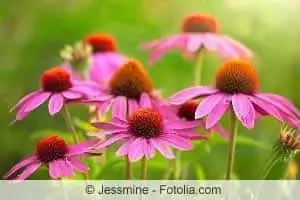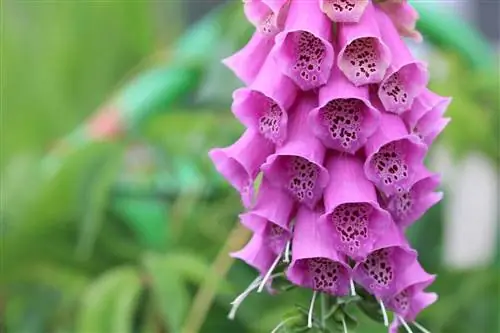- Author admin [email protected].
- Public 2023-12-17 03:39.
- Last modified 2025-01-24 12:45.
The Echinacea purpurea, also known as the purple coneflower, is a wonderful feast for the eyes. The Echinacea purpurea is one of the late bloomers and enchants the garden, especially in autumn, with its purple flowers. The hedgehog head, which usually appears in a darker red, is typical of this plant. The flowers themselves shine in a rich purple red.
Origin
Echinacea purpurea originally comes from North America, where it still grows today. In Europe the plant is grown as an ornamental plant and often appears in German gardens as a late bloomer.
Appearance
The appearance of purple coneflower is particularly wonderful when planted in groups. Under favorable conditions, the coneflower can reach a height of 60 to 180 cm. The plant can be recognized by its flower base, which is conical and slightly curved. It is reminiscent of a hedgehog, which is where the name hedgehog head comes from. In terms of color, the base of the flowers can be seen in a darker and richer red. The flowers are well described as long tubular flowers with very narrow leaves. The leaves of Echinacea purpurea are also elongated and lanceolate. It can often be seen that the petals are hanging, which does not seem strange given the length of 2 to 4 cm.
Sowing
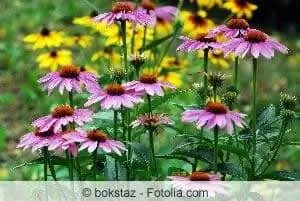
Sowing takes place in the months of April to May. It is not advisable to sow the plant in a pot as it can reach a very impressive height of 180 cm. However, it is not impossible to cultivate Echinacea purpurea in a pot. The planting distance is 30 to 40 cm so that the roots can spread well.
Location
As the name suggests, the coneflower needs a lot of sun so that it can produce good flowers. Echinacea purpurea can also grow and thrive in partial shade. However, in this case reduced flower formation can be seen. The soil should be well-drained and rich in humus. An optimal location is also close to the water. So if you have a pond in your garden, don't hesitate to choose a place near the pond.
Plants
The Echinacea purpurea is preferably planted outdoors in a sunny location from April to May.
Pouring
Echinacea purpurea is very undemanding and does not require a lot of care. If the plant is planted near water, it does not necessarily need to be watered. However, if the weather seems too dry, you should give the plant some water. Be careful not to keep the soil too moist.
Fertilize
You should be careful when fertilizing your coneflower. If you fertilize the plant too much, it will grow quickly, but this will weaken the plant too much. The result could be a twisting of the ankle and thus the death of the Echinacea purpurea. It is advisable to use compost or a complete fertilizer during the flowering period. A single application is often sufficient to supply the Echinacea purpurea with nutrients.
Cutting
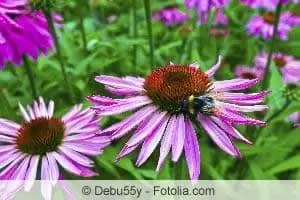
The flowering period for Echinacea purpurea is relatively short and only takes place from August to October. After flowering, you should cut the plant back to about a hand's width above the ground. By cutting back, the Echinacea purpurea can show off its full blooms again next year.
Wintering
Echinacea purpurea does not require much attention over the winter. If you cut back the coneflower immediately after flowering, only a small size will be left and it will not grow much over the winter. You can cover the plant with some foliage when temperatures get very low. As a rule, Echinacea purpurea can survive the winter unattended.
Propagate
Echinacea purpurea is a perennial plant that is propagated by root division every few years. The roots have strong growth, so you should divide them at least every 3 years. If you want to propagate Echinacea purpurea without dividing the roots, the only option is to sow again.
Tip:
Echinacea purpurea propagates vegetatively. However, a good tip is to propagate the plant using root cuttings, which is considered more productive.
Diseases and pests
Echinacea purpurea is actually very robust and requires little care. However, if the soil is too impermeable, waterlogging can occur, which can cause significant damage to the plant. Too much nutrient intake weakens the plant and can cause the stem to bend. If this happens, it is advisable to cut the plant back immediately. Avoid further fertilization during the following flowering period. If you see spots on the leaves, this may indicate a fungal disease. If you spot spots on the leaves, you should remove them as quickly as possible and also use a fungicide to prevent re-infestation.
Summary

Echinacea purpurea is a late bloomer that beautifies the garden with a purple-red color from August to October. Below you will find an overview of all the important properties of the plant:
- Height 60 to 180 cm
- Flowers mostly hanging
- easy maintenance
- hardy
- permeable soil required, preferably near water
Frequently asked questions
Which plants can Echinacea purpurea be combined with?
The full beauty of the plant occurs when you plant coneflowers in clusters. You can combine Echinacea purpurea with globe thistles, glossy loams, delphiniums, sunbride, sage, monkshood, asters, goldenrod or even the fine-beam aster. The splendor of the colors is best displayed in a separately created bed.
Can Echinacea purpurea be used as a cut flower?
The sun hat is very suitable for decorating the table in the living room. Due to the size of the coneflower, you can easily cut the plant during the flowering period and tie it as a bouquet. Make sure to add some nutrients to the water.
Does a fungicide have to be used in the event of a fungal or bacterial infection?
Once the plant has a disease, you must treat the plant. A fungicide is most effective at killing the bacteria or fungus. Alternatively, you can also fertilize the plant with nettle manure and spray the plant with it. However, if the disease persists, treatment with a fungicide is recommended as the diseases can also spread to other plants.
What you should know about purple coneflower soon
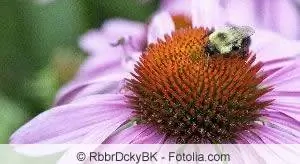
Other names
The red purple coneflower belongs to the daisy family (Asteraceae). Other German names for Rudbeckia purpurea are real coneflower, purple coneflower, purple coneflower, purple hedgehog head, red coneflower or red sunflower.
Care
- Unlike the yellow coneflower (Rudbeckia fulgida), the Echinacea purpurea is a very short-lived plant.
- If you want lush borders, you should sow the red coneflower regularly in spring.
- It is recommended to sow at around 15 °C, for example in a mini greenhouse.
Cutting
- Immediately after flowering, shorten to a hand's width above the ground.
- Because otherwise it could happen that the plant overexerts itself by producing seeds.
- Regular rejuvenation can be achieved by division in spring.
Application in medicine
- The perennial native to the American continent is also used in medicine.
- The purple coneflower was originally native to both North and South America.
- From there it was previously brought to Europe from wild collections.
- The medicinal herb is now cultivated worldwide.
The fresh or dried above-ground parts of the purple coneflower herb (Echinacea purpurea herba) are particularly used in medicine and homeopathic medicine. In addition, the sap obtained from the flowering above-ground parts of the plant and, more rarely, the root (Echinacea purpurea radix) are also used for medicinal purposes.
Other areas of application
Due to its germ-repellent effect, purple echinacea is used internally to treat chronic and recurring infections of the respiratory tract and urinary tract. Other common uses for purple echinacea include colds and flu. The purple coneflower active ingredient is said to increase the body's defenses. External use is also possible, for example for poorly healing, superficial wounds, small injuries, ulcers and skin inflammation. By the way: Purple coneflower is also available for horses, for example, as an additional feed to strengthen the immune system.

